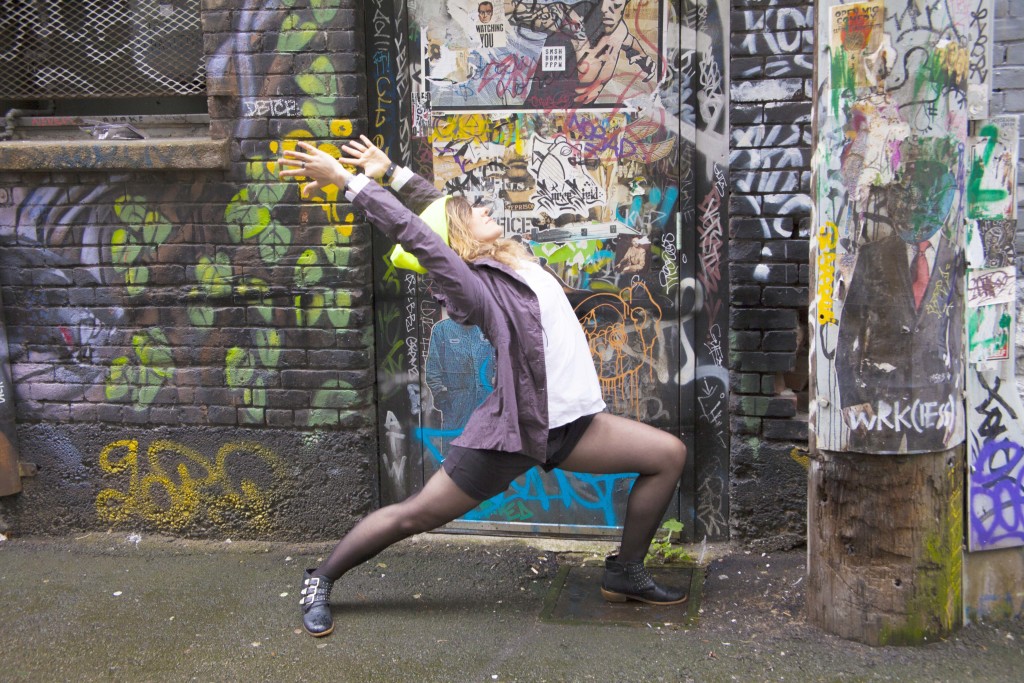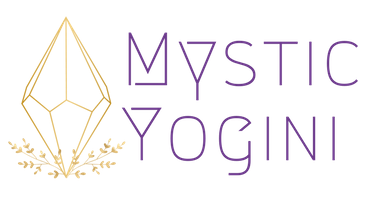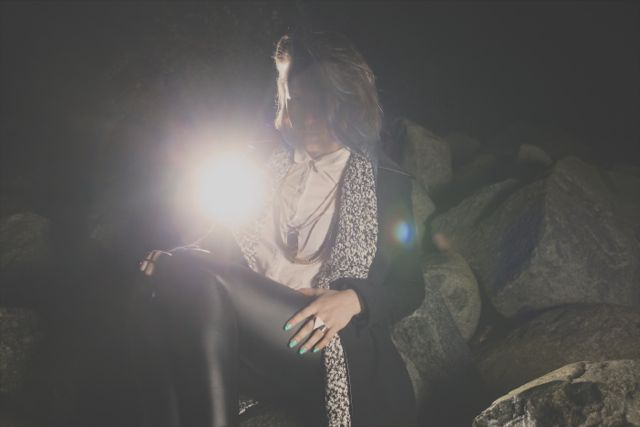This is a continuation of an interview series that began last week. Click here to go to the first part!
 MY: So I have a couple of questions more about your personal process and personal practice. Do you have a consistent daily practise and have you noticed how it’s changed? Is it more of an intuitive process?
MY: So I have a couple of questions more about your personal process and personal practice. Do you have a consistent daily practise and have you noticed how it’s changed? Is it more of an intuitive process?
E: I do not have a daily practise in the sense of doing a kriya and a meditation every single day but I do incorporate the philosophy of kundalini yoga and yoga and compassion into my life daily. And I do actually consciously check in and go inward even if I’m doing everyday things. I’ve kind of turned into more of an active mediator. I try to stay as aware and conscious as possible and always check in with myself. I used to be very unaware and out of touch with my feelings, thoughts and emotions. These days I do a daily check in without even realizing it maybe fifteen or twenty times, “How do I feel right now? Do I feel right about what I just did or what I just did?” Always coming back into my body, always coming back to my breath, if my breath is shallow something is a little off. I need to make it deeper, I need to inhale, I need to exhale, I need to come back to center, I need to always ask my inner compass what do I need right now?
MY: I think that’s such an important practice and such an important thing for people to realize. Spirituality is not necessarily about blocking out an hour and a half of time its about bringing it into your life and embodying it and becoming whatever that version of spirituality is for you. Its really linked to your authenticity and to who you are as a person. It’s not linked to oh yeah I do this practise therefore is all solved. Every day, every moment as conscious as you can be letting yourself get rid of all these other programs and layers stopping you from shining out who you really are as a person.
E: Definitely. And I do practise twice a week because I practise the kriya I’m going to teach the blind and then I do it with them. So the same kriya twice a week depending on what I’m teaching, or more when I have time.
MY: And that’s a little bit different than a traditional yoga class with you practising it with them. Is there a reason why you do that? I notice that I do that when I teach the women who have experienced trauma. I always do the kriyas with them.
E: For me it’s from a purely logistical standpoint because the blind cannot see what I am doing so I do a technique called railing where I will do a posture and I will get them to put their hands on my body to feel what I’m doing so they get an understanding of how that body part moves. My priorities in how I describe the moves are always like this: number one is my vocabulary and my verbal cues. That’s my top go-to. If they still don’t understand what the posture is supposed to be then I go to adjusting them with permission. If that also doesn’t work or they don’t stay in place then my third option is railing. Sometimes I will do spinal flex and that is a really hard one for some reason. I will sit next to them in easy pose and begin to flex my spine. I will ask them to gently place the palm of their hand on my back to see how my spine curves and they just instantly get it. And that is the main reason I do it with them. I want them to feel like I’m participating and we keep the tempo going and they’re always there to use me as a guide.
MY: Beautiful. Have you noticed your relationship with drugs and or alcohol and or partying change?
E: To be honest with you I have never been into drug or party culture very much. The kind of activities that really entertain me or the kinds of activities I like more are art, live music shows, I love getting together with friends for a glass of wine. I don’t use recreational drugs very frequently so I can’t say that that has changed but generally speaking after every single time I do yoga I feel like I’ve taken an internal shower like I’ve just cleaned myself and even drinking a glass of wine at that point feels like I’m somehow harming my body. If I haven’t done it in a while, yeah its no problem to have a glass of wine, but if I just did a yoga class its the last thing I’m thinking about because I feel so good.
MY: That makes sense. Fair enough. And have you noticed if your relationships to other people have changed – that you surround yourself with other people or just the way you relate to people has changed?
E: Yes, I feel into people a lot more. When I listen to them in a conversation I really listen to them and I respond in ways that let them know I really get them emotionally. I want to pay special attention to them. People, they want to be heard. I’ve started to care less and less about ego talk and more and more about making them feel that they’ve got my ear and attention. Now that I’ve gotten better and better at establishing my own boundaries and voicing what I want I feel like that’s also shifted the way I converse with other people where I want them to feel the same way so I extract from them “How do you feel? What do you think about this?” and draw conclusions based on things they tell me. That’s the way my communication has shifted.
And the kinds of people I surround myself with has also changed. I’m definitely gravitating to people who are creative, people who are positive. I’ve had the good fortune of being surrounded by people who are just good people in this world. I think it’s a reflection of who you are I guess. I’ve never had any major drama in my life. I’ve always hung out with good people, it sounds kind of cheesy and simple, but I have started to gravitate to more people who are like myself – they either creative or have more leadership qualities. I get bored really easy in conversations if they are not stimulating my brain in the direction of what action can we take.
 MY: If there is somebody who wanted to start a kundalini yoga practice what would be your recommendation?
MY: If there is somebody who wanted to start a kundalini yoga practice what would be your recommendation?
E: Start small. That’s the only way I believe is effective to develop a long term habit. Don’t try to take on all of kundalini yoga at once. Give yourself some time to progress. Pick one thing you really love to do. Play around with a couple of different breathing techniques and play around with a couple of different kriyas or maybe even specific postures. Do five minutes a day and grow to ten minutes a day and then fifteen. If you want to dive in right away, if you’re in that mentality, do it but stick to it. Do it and stick to it. And reward yourself in some way that is meaningful for you.
MY: And do you think they should follow the traditional 40, 90, 120, 1000 days right off the bat or should they allow the practise and discipline to grown?
E: Allow the practise and discipline to grow. I think that even opening myself up to kundalini was random sporadic classes that intrigued me to keep on going. It wasn’t until a year into my practise that I actually committed to forty days. That was when I was living in New York and that forty days changed so much of my life. I think that the forty day practise comes to you when you ready but don’t feel pressured to dive right into that.
MY: I think those are wise words. I my first kundalini classes, I took a set over eight weeks and it wasn’t until four or five years later I actually dove into kundalini head first. It definitely comes with time when you are ready for sure. Do you have any current favourite kriyas or meditations?
E: One that has been especially effective for me has been Subagh kriya, so kriya for abundance, I absolutely love. Even from practising it once –
MY: I hate that one. {both laugh}
E: You know, despite how it feels its the aftermath that matters. As long as you’re getting results. I absolutely love that one and abundance can come in so many forms and I always feel it after. I love Surya Kriya because it’s a really nice way to energize yourself. Man. Kirtan Kriya. That one is my arch nemesis and my best friend at the same time. I really, really had such a strong resistance to that one in teacher training and honestly its probably the one that has caused the most shifts in my life. What you resist persists haha.
MY: Do you have any favourite music right now in your practise? Chants or anything to do yoga to?
E: My favourite kundalini artist is Nirinjin Kaur. I think she has an amazing voice, but to be honest I am a very non-traditional kundalini yogi in the sense that I don’t use kundalini music frequently. My practice music is ambient electronic and I would say it’s my favorite genre all around. I co-hosted a radio show for a little bit that was specifically focused on it.
MY: Yes, I know, that’s why I specified Kundalini Music {laughter}. Do you have anything else you would like to say?
E: I think its time to make kundalini yoga more relevant to young people. I think it’s really interesting time because the millennial generation is looking for spiritual fulfillment more than ever – more of a universal and personal connection than a specific religion. Just a way to live right and be happy.We are no longer like our parents or grandparents generation who built the infrastructure society as we are now in the digital age. We realize we actually have a choice in our careers we have a choice in our lifestyle we have a choice in marriage or not, kids or not, we have a lot of options. Because of that a lot of people are seeking spiritual guidance but spiritual guidance is often packaged in an outdated and traditional way.
MY: Yes, we are transitioning from the Piscean age to the Aquarian age and I find a lot of things are Piscean. I can tell because they feel restrictive, boxy and not expansive. How do you think kundalini yoga could be made more relevant to this generation?
E: I think it could be made more relevant by not needing to stick to a specific attire or music. I think it comes in the form of understanding the philosophy and packaging that in a way that feels really authentic to you.
MY: Where do you see yourself going with kundalini yoga?
E: For the time being I’d like to continue to teach it to the blind because that continues to help my personal growth and as a teacher. In the future I hope to continue to teach it part time because I have a full time job as a video producer but I definitely hope to continue offering classes to people who can’t make it to yoga studios.
MY: Do you think you are one of the major leaders in repackaging kundalini yoga?
E: I think myself, and everyone does, have the potential to be. I have video production skills which are such a valuable marketing tool so I have a way to spread that look of kundalini yoga to a very wide audience.
MY: I could definitely see you in that role because you have such an expertise in branding and such a deep understanding of both the worlds – the yoga world and the physical world and what people want to see and how to gear that to audiences. I can definitely see that in your future. I am looking forward to seeing what the future brings you and what you end up doing.
E: Thank you. I definitely have a very strong interest in design, aesthetic, and fashion and it’s a little bit contrary to the kundalini yoga traditional attire to say the least.
MY: {laughing}Yeah, I know. I teach all in black sometimes… Thank you so much for the interview! I enjoyed it a lot!
Some of Elena’s Favorite Music:
Chrome Sparks – Send the Pain On
 Elena is a video producer and part time yoga teacher, currently based out of Vancouver, BC. In her free time, she embarks on creative adventures in front of and behind the camera.
Elena is a video producer and part time yoga teacher, currently based out of Vancouver, BC. In her free time, she embarks on creative adventures in front of and behind the camera.
** All pictures in this series were provided to me by Elena.

